Realtek Semiconductor RTL8188CEBT 802.11b/g/n RTL8188CE Combo miniCard User Manual S100 User Guide V1 0 en
Realtek Semiconductor Corp. 802.11b/g/n RTL8188CE Combo miniCard S100 User Guide V1 0 en
Contents
- 1. User Manual
- 2. manual host
- 3. manual module
manual host

Lenovo IdeaPad S100
Read the safety notices and important tips in the
included manuals before using your computer.
©Lenovo China 2011
New World. New Thinking.TM
www.lenovo.com
User Guide V1.0
V1.0_en-US

First Edition (January 2011)
© Copyright Lenovo 2011.
LIMITED AND RESTRICTED RIGHTS NOTICE: If data or software are delivered pursuant a General
Services Administration “GSA” contract, use, reproduction, or disclosure is subject to restrictions set
forth in Contract No. GS-35F-05925.
Note
Regulatory Notice
•Before using the product, be sure to read Lenovo Safety and General
Information Guide first.
•Some instructions in this guide may assume that you are using
Windows® 7. If you are using other Windows operating system, some
operations may be slightly different. If you are using other operating
systems, some operations may not apply to you.
•The features described in this guide are common to most models.
Some features may not be available on your computer and/or your
computer may include features that are not described in this user
guide.
•The illustrations in this manual may differ from the product you are
using.
•To refer to it, go to http://consumersupport.lenovo.com/ and click
User guides and manuals.
i
Chapter 1. Getting to know your computer .......................................... 1
Top view.......................................................................................................................1
Left-side view ..............................................................................................................3
Right-side view............................................................................................................4
Front view ....................................................................................................................4
Bottom view .................................................................................................................5
Chapter 2. Learning the basics.............................................................. 6
First use.........................................................................................................................6
Using AC adapter and battery ..................................................................................8
Using the touchpad...................................................................................................10
Using function keys ..................................................................................................11
Connecting external devices....................................................................................13
System status indicators...........................................................................................17
Using Lenovo Quick Start........................................................................................19
Chapter 3. Connecting to the Internet................................................. 21
Wired connections.....................................................................................................21
Wireless connections.................................................................................................23
Chapter 4. OneKey Rescue system..................................................... 25
OneKey Rescue system ............................................................................................25
Chapter 5. Troubleshooting ................................................................. 28
Frequently asked questions .....................................................................................28
Troubleshooting ........................................................................................................30
Trademarks............................................................................................ 35
Contents
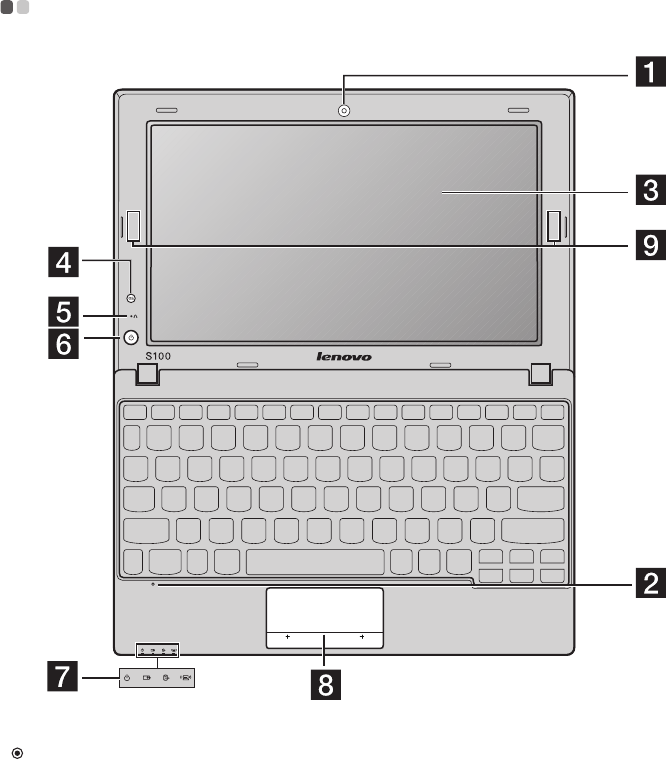
1
Chapter 1. Getting to know your computer
Top view - - - - - - - - - - - - - - - - - - - - - - - - - - - - - - - - - - - - - - - - - - - - - - - - - - - - - - - - - - - - - - - - - - - - - - - - - - - - - - - - - - - - - - - - - - - - - - - - - - -
Attention:
•Do NOT open the display panel beyond 130 degrees. When closing the display panel, be
careful NOT to leave pens or any other objects in between the display panel and the
keyboard. Otherwise, the display panel may be damaged.

2
Chapter 1. Getting to know your computer
Integrated
camera
Use the camera for video communication.
Built-in
microphone
The built-in microphone (with noise reduction) can be
used for video conferencing, voice narration, or simple
audio recordings.
Computer display The computer display with LED backlight provides
brilliant visual output.
QS (Quick Start)
button
When the computer is powered off, press this button to
start Lenovo Quick Start.
OneKey Rescue
system button
When the computer is powered off, press this button to
start Lenovo OneKey Rescue system.
Note: For details, see “OneKey Rescue system” on page 25.
Power button Press this button to turn on the computer.
System status
indicators
For details, see “System status indicators” on page 17.
Touchpad The touchpad functions as a conventional mouse.
Wireless module
antennas
The built-in antennas ensure optimal reception of wireless
radio.
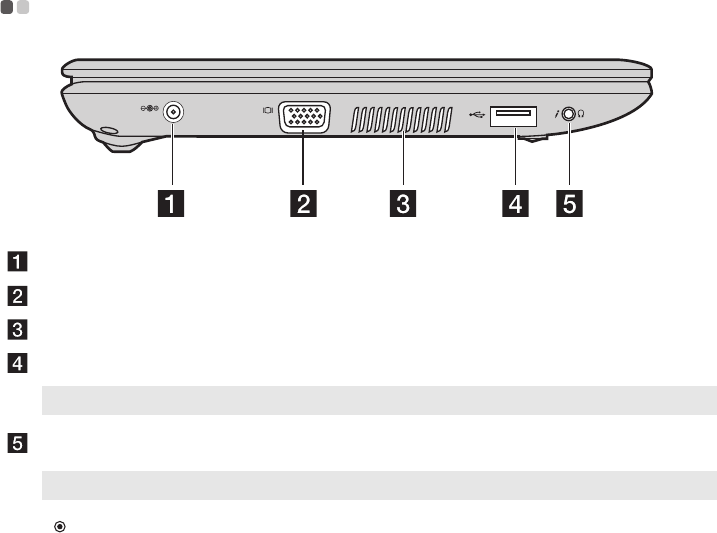
Chapter 1. Getting to know your computer
3
Left-side view - - - - - - - - - - - - - - - - - - - - - - - - - - - - - - - - - - - - - - - - - - - - - - - - - - - - - - - - - - - - - - - - - - - - - - - - - - - - - - - - - - - - - -
AC power adapter jack Connect the AC adapter here.
VGA port Connects to external display devices.
Fan louvers Dissipate internal heat.
USB port Connects to USB devices.
Note: For details, see “Connecting USB devices” on page 15.
Combo audio jack Connects to headsets or headphones.
Note: The combo audio jack does not support a conventional microphone.
Attention:
•Listening to music at high volume over extended periods of time may damage your
hearing.
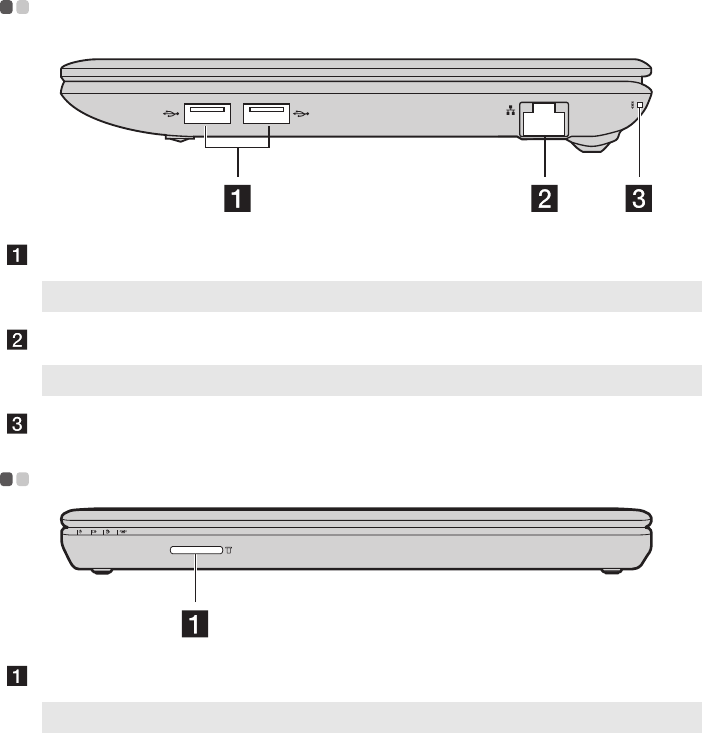
4
Chapter 1. Getting to know your computer
Right-side view - - - - - - - - - - - - - - - - - - - - - - - - - - - - - - - - - - - - - - - - - - - - - - - - - - - - - - - - - - - - - - - - - - - - - - - - - - - - - - - - - -
Front view - - - - - - - - - - - - - - - - - - - - - - - - - - - - - - - - - - - - - - - - - - - - - - - - - - - - - - - - - - - - - - - - - - - - - - - - - - - - - - - - - - - - - - - - - - - - - - -
USB port Connects to USB devices.
Note: For details, see “Connecting USB devices” on page 15.
RJ-45 port This port connects the computer to an Ethernet network.
Note: For details, see “Wired connections” on page 21.
Lanyard hole Used for attaching a lanyard (not supplied).
Memory card slot
Insert memory cards (not supplied) here.
Note: For details, see “Using memory cards (not supplied)” on page 13.

Chapter 1. Getting to know your computer
5
Bottom view - - - - - - - - - - - - - - - - - - - - - - - - - - - - - - - - - - - - - - - - - - - - - - - - - - - - - - - - - - - - - - - - - - - - - - - - - - - - - - - - - - - - - - - - - -
Battery latch -
manual
The manual battery latch is used to keep the battery pack
secured in place.
Battery pack
For details, see “Using AC adapter and battery” on page 8.
Battery latch -
spring loaded
The spring-loaded battery latch keeps the battery pack
secured in place.
Speakers The stereo speakers provide rich and powerful sound.

6
Chapter 2. Learning the basics
First use
- - - - - - - - - - - - - - - - - - - - - - - - - - - - - - - - - - - - - - - - - - - - - - - - - - - - - - - - - - - - - - - - - - - - - - - - - - - - - - - - - - - - - - - - - - - - - - - - - - - - - - -
Reading the manuals
Read the supplied manuals before using your computer.
Connecting to the power
The supplied battery pack is not fully charged at purchase.
To charge the battery and begin using your computer, insert the battery pack
and connect the computer to an electrical outlet. The battery is automatically
charged while the computer is running on AC power.
Installing the battery pack
Refer to the supplied Setup Poster to install the battery pack.
Connecting the computer to an electrical outlet
1
Connect the power cord to the AC adapter.
2
Connect the AC adapter to the AC power adapter jack of the computer
firmly.
3
Plug the power cord into an electrical outlet.
Turning on the computer
Press the power button to turn on the computer.
Configuring the operating system
You may need to configure the operating system when it is first used. The
configuration process may include the procedures below.
• Accepting the end user license agreement
• Configuring the Internet connection
• Registering the operating system
• Creating a user account

Chapter 2. Learning the basics
7
Putting your computer into sleep state or shutting it down
When you finish working with your computer, you can put it into sleep state
or shut it down.
Putting your computer into sleep state
If you will be away from your computer for only a short time, put the
computer into sleep state.
When the computer is in sleep state, you can quickly wake it to resume use,
and bypass the startup process.
To put the computer into sleep state, do one of the following.
• Click and select Sleep from the Start menu.
•Press Fn + F1.
To wake the computer, do one of the following.
• Press the power button.
• Press any key on the keyboard.
Shutting down your computer
If you are not going to use your computer for a day or two, shut it down.
To shut down your computer, click and select Shut down from the Start
menu.
Note: Wait until the power indicator light starts blinking (indicating that the computer is
in sleep state) before you move your computer. Moving your computer while the
hard disk is spinning can damage the hard disk, causing loss of data.

8
Chapter 2. Learning the basics
Using AC adapter and battery
- - - - - - - - - - - - - - - - - - - - - - - - - - - - - - - - - - - - - - - - - - - - - - - - - - - - - - - - - -
Checking battery status
You can determine the percentage of battery power remaining by checking
the battery icon in the notification area.
Charging the battery
When you find that the battery power is low, you need to charge the battery
or replace it with a fully charged one.
You need to charge the battery in any of the following situations:
• When you purchase a new battery
• If the battery status indicator starts blinking
• If the battery has not been used for a long time
Note: As each computer user has different habits and needs, it is difficult to predict how
long a battery charge will last. There are two main factors:
• The amount of energy stored in the battery when you commence work.
• The way you use your computer: for example, how often you access the hard
disk drive and how bright you make the computer display.
Note:
•You are advised to insert the battery pack when using your computer to prevent small
particles from entering the inside of your computer.
•To increase the life of the battery pack, the computer does not start recharging the
battery immediately after it drops from fully charged.
•Charge the battery at a temperature between 50 °F and 86 °F (10 °C-30 °C).
•Full charge or discharge is not required.
Chapter 2. Learning the basics
9
Removing the battery pack
If you are not going to use the computer for an extended period of time, or if
you need to send your computer to Lenovo for service, etc. remove the
battery pack from the computer. Before removing the battery pack, make
sure the computer has been shut down.
Handling the battery
If the rechargeable battery pack is replaced with an incorrect type, there may
be danger of an explosion. The battery pack contains a small amount of
harmful substances. To avoid possible injury and detriment to the
environment, pay attention to the following points:
• Replace only with a battery of the type recommended by Lenovo.
• Keep the battery pack away from fire.
• Do not expose the battery pack to water or rain.
• Do not attempt to disassemble the battery pack.
• Do not short-circuit the battery pack.
• Keep the battery pack away from children.
• Do not put the battery pack in trash that is disposed of in landfills. When
disposing of the battery, comply with local ordinances or regulations and
your company's safety standards.
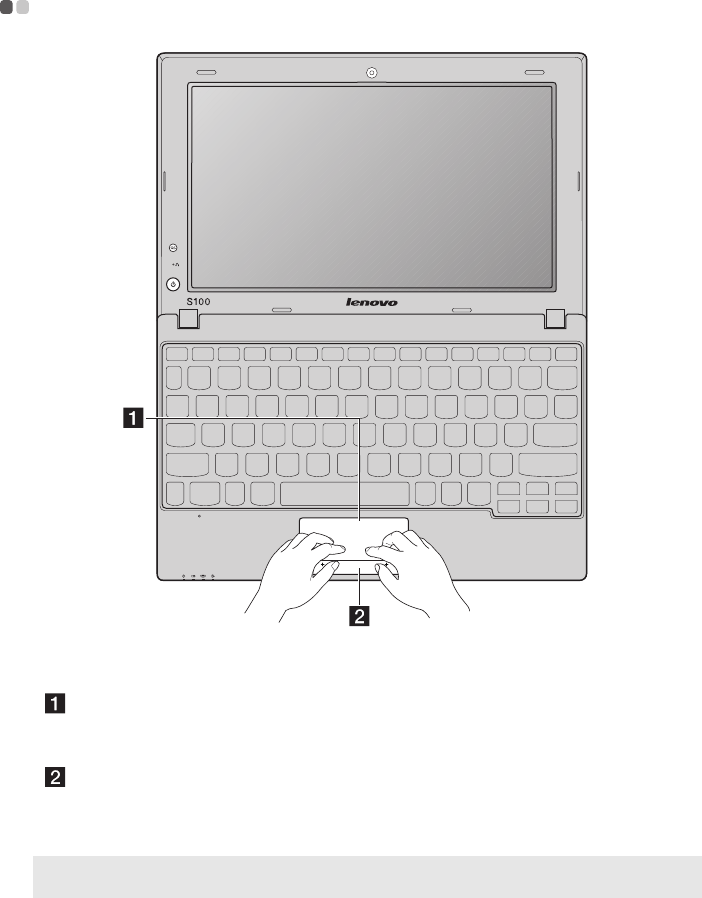
10
Chapter 2. Learning the basics
Using the touchpad
- - - - - - - - - - - - - - - - - - - - - - - - - - - - - - - - - - - - - - - - - - - - - - - - - - - - - - - - - - - - - - - - - - - - - - - - - - - - - - -
Touchpad To move the cursor on the screen, slide your
fingertip on the touchpad in the direction in
which you want the cursor to move.
Left-/Right-click
area
The function of the left-/right-click area
corresponds to that of the left/right mouse
button on a conventional mouse.
Note: You can enable/disable the touchpad using Fn + F6. When the touchpad indicator is
lit, the touchpad is disabled.
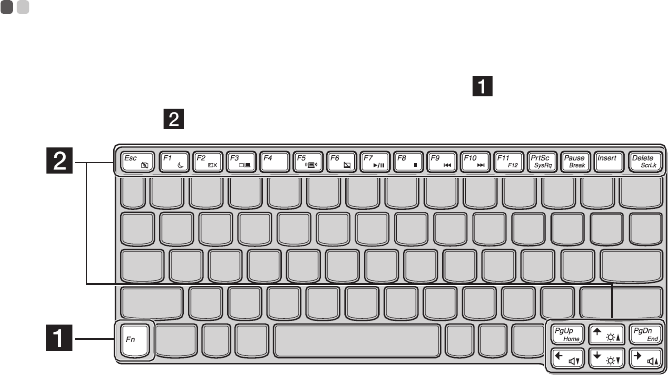
Chapter 2. Learning the basics
11
Using function keys
Through the use of the function keys, you can change operational features
instantly. To use this function, press and hold Fn ; then press one of the
function keys .
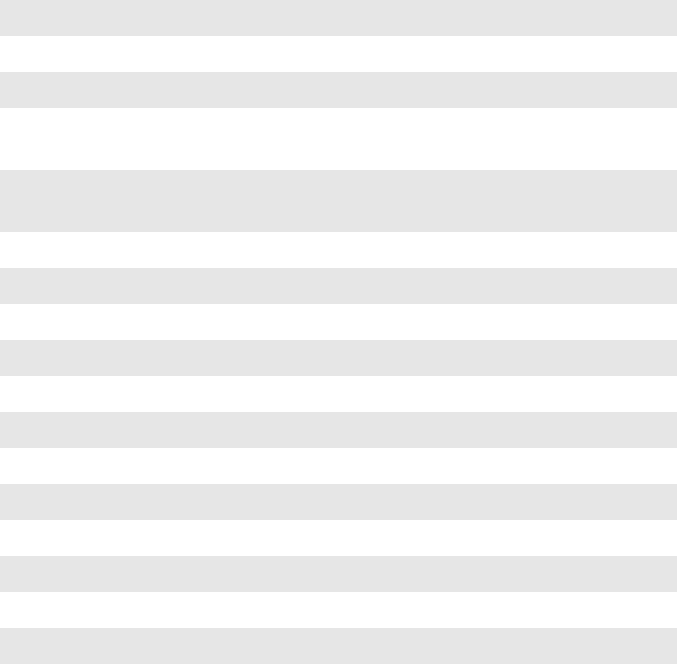
12
Chapter 2. Learning the basics
The following describes the features of each function key.
Fn + Esc: Turn on/off the integrated camera.
Fn + F1: Enter sleep mode.
Fn + F2: Turn on/off the backlight of the LCD screen.
Fn + F3: Open the interface for the display device switch
to select this notebook or an external display.
Fn + F5: Open the interface for integrated wireless
devices settings (On/Off).
Fn + F6: Enable/Disable the touchpad.
Fn + F7: Start/Pause playback of Windows Media Player.
Fn + F8: Stop playback of Windows Media Player.
Fn + F9: Skip to the previous track.
Fn + F10: Skip to the next track.
Fn + F11: F12 key
Fn + PrtSc: Activate the system request.
Fn + Pause: Activate the break function.
Fn + Delete: Enable/Disable the scroll lock.
Fn + PgUp Home key
Fn + PgDn End key
Fn + ↑ / ↓:Increase/Decrease display brightness.
Fn + → / ←:Increase/Decrease sound volume.
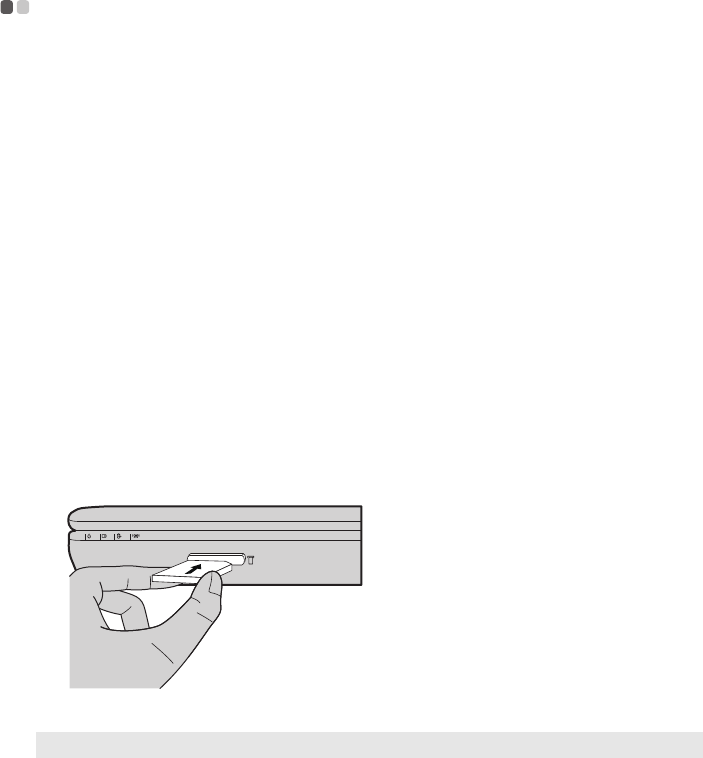
Chapter 2. Learning the basics
13
Connecting external devices
- - - - - - - - - - - - - - - - - - - - - - - - - - - - - - - - - - - - - - - - - - - - - - - - - - - - - - - - - - - -
Your computer has a wide range of built-in features and connection
capabilities.
Using memory cards (not supplied)
A memory card is a data storage device used for storing digital information
that is commonly used in many electronic devices. Your computer is
equipped with a memory card reader compatible with the following types of
memory cards:
• Secure Digital (SD) card
• MultiMediaCard (MMC)
Your computer can be used to read data from and write data to these types of
memory cards.
Inserting a memory card
You must insert a memory card before you can read data from or write data
to it with your computer. To insert a memory card:
1
Align the memory card with the card slot, with the metal contacts facing
downwards.
2
Gently slide the memory card into the card slot until it reaches the end.
Note: Insert only one card at a time into the slot.
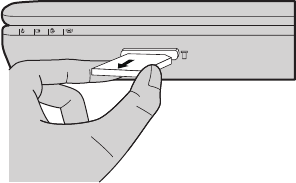
14
Chapter 2. Learning the basics
Removing a memory card
After reading data from and/or writing data to the memory card, you can
remove it from your computer. To remove a memory card:
1
Use the Windows Safely Remove Hardware utility to make sure the card
is not in use.
2
Gently pull the memory card out of the card slot.
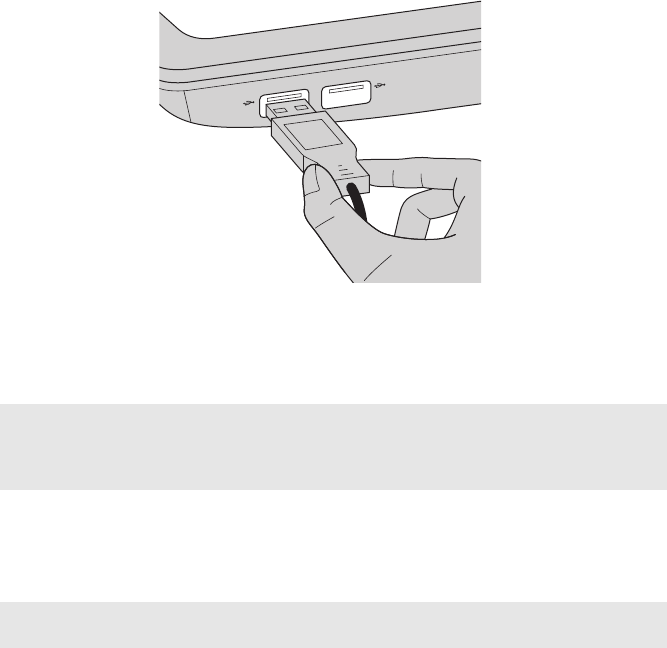
Chapter 2. Learning the basics
15
Connecting USB devices
You can connect a USB device to your computer by inserting its USB plug
(Type A) into the USB port on your computer.
The first time you plug a USB device into a particular USB port on your
computer, Windows automatically installs a driver for that device. After the
driver is installed, you can disconnect and reconnect the device without
performing any additional steps.
Before disconnecting a USB storage device, make sure your computer has
finished transferring data by that device. Click the Safely Remove Hardware
icon in the notification area of Windows to remove the device before
disconnecting.
Note: Typically, Windows detects a new device after connecting it, and then installs the
driver automatically. However, some devices may require you to install the driver
before connecting. Check the documentation provided by the device's manufacturer
before connecting the device.
Note: If your USB device uses a power cord, connect the device to a power source before
connecting it. Otherwise, the device may not be recognized.

16
Chapter 2. Learning the basics
Connecting Bluetooth-enabled devices (on select models)
If your computer has an integrated Bluetooth(R) adapter, it can connect to
other Bluetooth-enabled devices, such as notebook computers, PDAs, and
mobile phones, and transfer data wirelessly to and from them over a range of
up to 10 meters in open areas.
Enabling Bluetooth communication on your computerr
You must enable Bluetooth communication on your computer before pairing
your computer with other Bluetooth-enabled devices.
To enable Bluetooth communication on your computer:
1
Press Fn+F5; a list of wireless features will be displayed.
2
Enable Bluetooth communication with a single click.
Pairing your computer with other Bluetooth-enabled devices
The first time you connect your computer to another Bluetooth-enabled
device, you must pair the device with your computer as follows:
1
Enable Bluetooth communication on the device and set it to discoverable
mode.
2
Enable Bluetooth communication on your computer.
3
On your computer, go to Control Panel and click Add a device. The
device you want to connect to should appear on the device list. Click the
device and then click Next. Your computer will generate a pairing code
and display it on the screen.
4
On your device, accept the pairing invitation and enter the pairing code
displayed on your computer screen. The connection will be established
and Windows will automatically install drivers for the device if
necessary.
Once the connection is established, you can exchange data between your
computer and the Bluetooth-enabled device.
Note: The actual maximum range may vary due to interference and transmission barriers.
For the best possible connection speed, place the device as near to your computer as
possible.
Note: When you do not need Bluetooth communication, disable it to save battery power.
Note: Read the documentation supplied with the device for details.
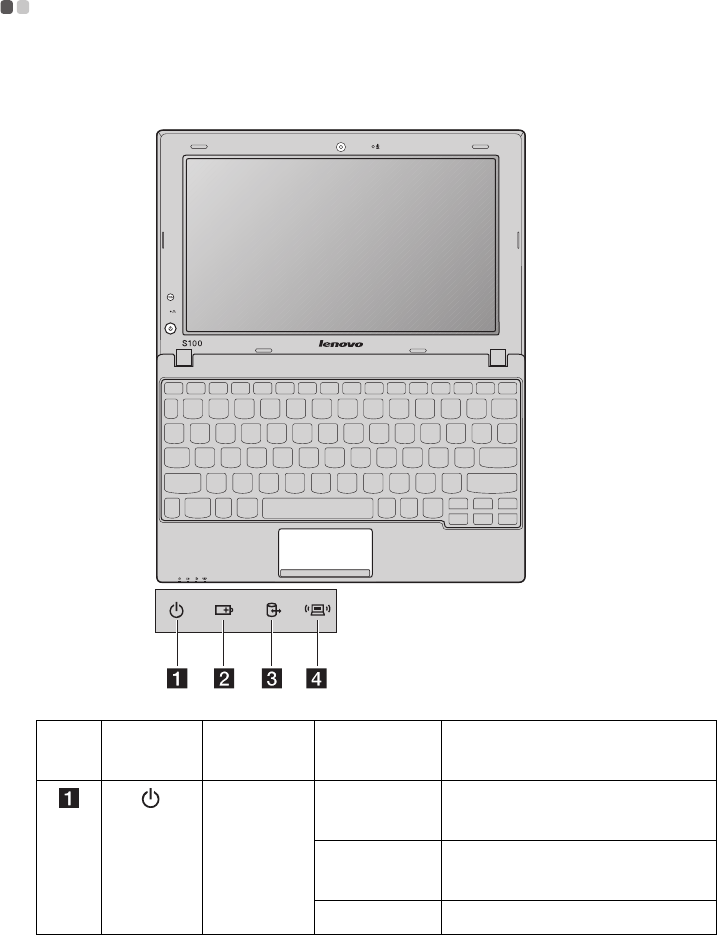
Chapter 2. Learning the basics
17
System status indicators
- - - - - - - - - - - - - - - - - - - - - - - - - - - - - - - - - - - - - - - - - - - - - - - - - - - - - - - - - - - - - - - - - - - -
The system status indicators show the current computer status. The
following diagram shows the location of the indicators and the table lists
their statuses and meanings.
No. Symbol Indicator Indicator
status
Meaning
Power On (solid
white)
The computer is powered on.
Blinking The computer is in sleep
mode.
Off The computer is powered off.
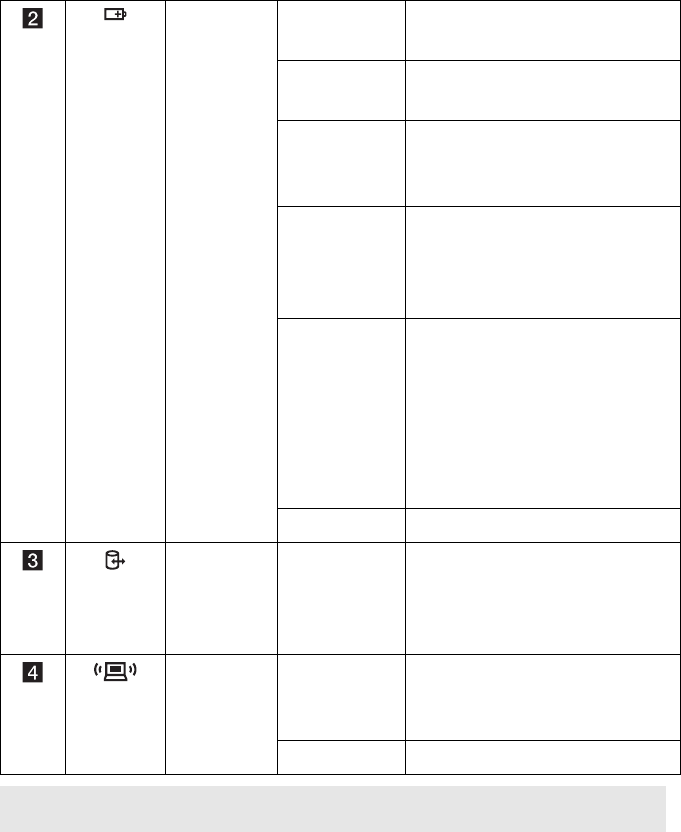
18
Chapter 2. Learning the basics
Battery On (solid
white)
The battery has more than
20% charge.
Solid amber The battery has between 5%
and 20% charge.
Fast
blinking
amber
The battery has less than 5%
charge.
Slow
blinking
amber
The battery is being charged.
When battery charge reaches
20%, the blinking color
changes to white.
Slow
blinking
white
The battery has between 20%
and 80% charge and is still
charging. When the battery
reaches 80% charge the light
will stop blinking, but
charging will continue until
the battery is fully charged.
Off The battery is detached.
Device
access
Blinking Data is being read from or
written to the hard disk drive
or other external storage
devices.
Wireless On Wireless (Bluetooth or
wireless network card) is
enabled.
Off Wireless is disabled.
Note: Do not power off the computer or put the computer into sleep (hibernation) mode
when the device access indicator is blinking.

19
Chapter 2. Learning the basics
Using Lenovo Quick Start
- - - - - - - - - - - - - - - - - - - - - - - - - - - - - - - - - - - - - - - - - - - - - - - - - - - - - - - - - - - - - - - - - -
With a boot time of just a few seconds, Lenovo Quick Start offers a handy
environment that allows you to enjoy instant access to functions such as Web
browsing, instant messaging and other entertainment functions without
entering the traditional operating system.
Starting Lenovo Quick Start
To start Lenovo Quick Start:
1
Power off the computer.
2
Press the QS button; Lenovo Quick Start will start and be ready to use
within a few seconds.
Exiting Lenovo Quick Start
When you finish using Lenovo Quick Start, you can either power off the
computer or start the Windows operating system.
To power off the computer, click the Power off button in the lower left hand
corner of the screen.
To enter Windows, click the Enter OS button in the lower left hand corner of
the screen; the computer will restart using the Windows operating system.
Note: If Lenovo Quick Start is not installed, a prompt will appear on the screen when you
start it.
20
Chapter 2. Learning the basics

21
Chapter 3. Connecting to the Internet
As a global network, the Internet connects computers worldwide, providing
services such as sending and receiving e-mail information searching, elec-
tronic commerce, Web browsing and entertainment.
You can connect the computer to the Internet in the following ways:
Wired connections: use physical wiring to connect.
Wireless connections: connect through a wireless router.
Wired connections - - - - - - - - - - - - - - - - - - - - - - - - - - - - - - - - - - - - - - - - - - - - - - - - - - - - - - - - - - - - - - - - - - - - - - - - - -
Wired connections are a reliable and safe way to connect the computer to the
Internet.
Cable Cable Internet services use a cable modem connected to
the residential cable TV line.
DSL DSL is a family of related technologies that bring
highspeed network access to homes and small
businesses over ordinary telephone lines.
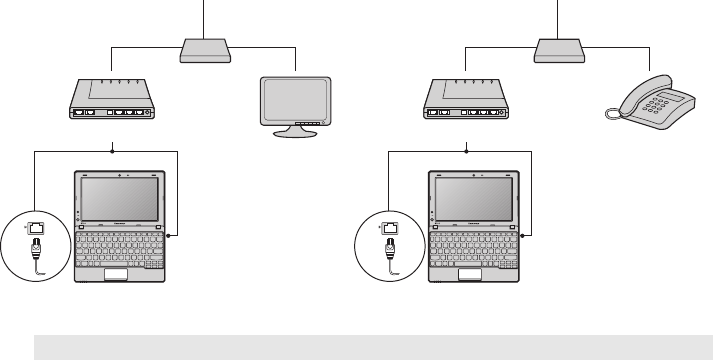
22
Chapter 3. Connecting to the Internet
Hardware for wired connections
Cable DSL
Software configuration
Consult your Internet Service Provider (ISP) or network administrator for
details on how to configure your computer.
Note: The above diagrams are for reference only. Actual connection method may vary.
*
*
**
TV cable
Splitter *
Cable modem *
* Not supplied.
Telephone line
Splitter *
DSL modem *
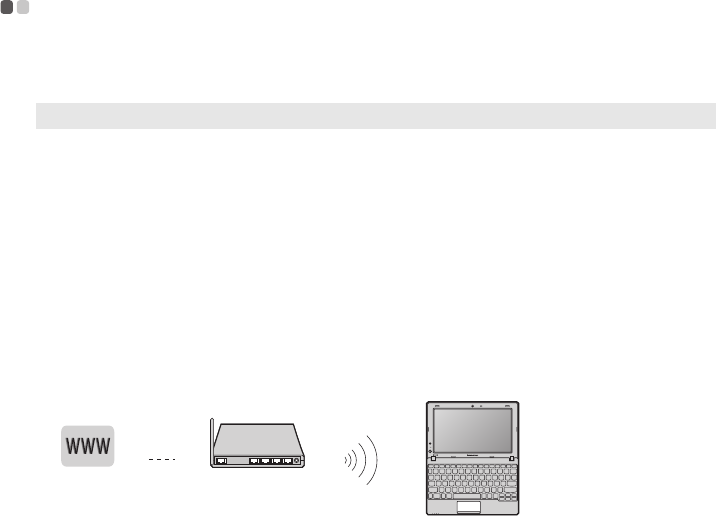
Chapter 3. Connecting to the Internet
23
Wireless connections - - - - - - - - - - - - - - - - - - - - - - - - - - - - - - - - - - - - - - - - - - - - - - - - - - - - - - - - - - - - - - - - - - - - - - - - -
Your computer comes with a built-in wireless network card. This allows you
to connect to the Internet wirelessly through a wireless network.
Enabling the wireless network card
You must enable the wireless network card before connecting to a wireless
network. To enable the wireless network card:
1
Press Fn+F5; a list of wireless features will be displayed.
2
Enable wireless network card with a single click.
Hardware for wireless connections
Connecting to a wireless network
Before connecting to a wireless network, obtain the following information
from the network administrator:
• The network name (SSID)
•The security key
Once you get the network name and the security key, you can connect your
computer to the wireless network. To connect to the wireless network:
1
Make sure the wireless network card is enabled and the computer is
placed within the coverage range of the wireless network.
2
Go to Control Panel on your computer and click Network and Sharing
Center; click Connect to a network to display all wireless networks
within range.
Note: A wireless network is a computer network which uses wireless routers as access points.
Wireless router *
The Internet
* Not supplied
Chapter 3. Connecting to the Internet
24
3
Select the name of your wireless network and click Connect; enter your
security key when prompted.

25
Chapter 4. OneKey Rescue system
OneKey Rescue system
- - - - - - - - - - - - - - - - - - - - - - - - - - - - - - - - - - - - - - - - - - - - - - - - - - - - - - - - - - - - - - - - - - - - - -
Introduction
The Lenovo OneKey Rescue system is an easy-to-use application that can be
used to back up the data on your system partition (C drive) for easy restore
when required. You can run Lenovo OneKey Recovery under the Windows
operating system, and the OneKey Rescue system without starting the
Windows operating system.
Attention:
In order to utilize the features of the OneKey Rescue system, your hard disk
already includes a hidden partition by default to store the system image file
and OneKey Rescue system program files. This default partition is hidden
for security reasons and is the reason the available disk space is less than it
claims. The exact available hard disk space depends on the file size of the
mirror image file (based on the size of operating system and pre-installed
software).
Using Lenovo OneKey Recovery (within Windows operating
system)
In Windows operating system, double click the OneKey Recovery system
Icon on the desktop to launch Lenovo OneKey Recovery.
Within the program, you can back up the system partition on the hard disk
drive, other storage devices, or by creating recovery discs.
For more instructions, see the Help file of Lenovo OneKey Recovery.
Note:
•The backup process and creation of recovery discs may take some time, connect the AC
adapter and battery pack to your computer.
•After the recovery discs are burned, please number them so that you can use them in the
correct order.
•Computers without an integrated optical drive support the creation of recovery discs;
however an appropriate external optical drive is needed to physically create the recovery
discs.
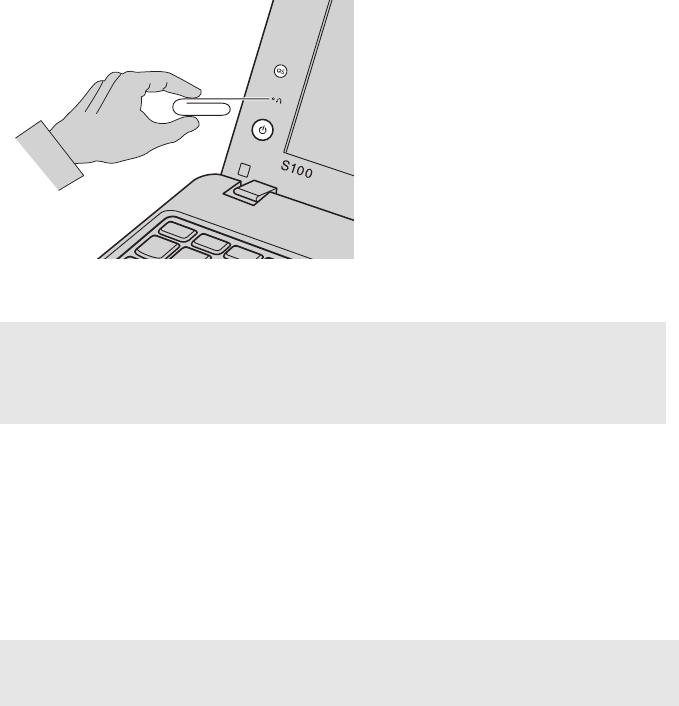
26
Chapter 4. OneKey Rescue system
Using Lenovo OneKey Rescue system (without Windows
operating system)
In the event that the operating system cannot be loaded, follow the steps
below to start OneKey Rescue system.
• Shut down your computer.
• Press the OneKey Rescue system button to start OneKey Rescue system.
Within the program, you can choose to restore your system partition to the
original factory status, or to a previously generated backup.
Creating a recovery disc(s)
Your computer does not ship with a recovery disc. You can use Lenovo
OneKey Recovery system to create a recovery disc(s), which can be used to
start and restore your computer in case of a system failure.
To create a recovery disc(s):
• Insert a recordable disc into the optical drive on your computer.
• In Windows, press the OneKey Rescue system button to launch Lenovo
OneKey Recovery system.
Note:
•The recovery process is irreversible. Make sure to back up any critical data before using
the recovery feature.
•You can use the tip of an unfolded paper clip (or similar object without a sharp tip) to
gently press the OneKey Rescue system button.
Note: If your computer does not come with an integrated optical drive or if the integrated
optical drive does not support disc creating, connect an appropriate external optical
drive to your computer.

27
Chapter 4. OneKey Rescue system
• On the main screen, click Create Recovery Disc.
• Choose the type of recovery disc(s). You can create three types of recovery
disc(s): recovery disc(s) with existing backup image, recovery disc(s) from
the current system partition, and factory default recovery disc(s). Select the
type of recovery disc you want to create and follow the on-screen
instructions.
• Insert additional recordable disc(s) when prompted.
Note:
•The estimated number of discs needed will be displayed before the process of creating the
recovery disc(s) begins. To minimize the number of discs needed, use recordable DVDs as
the media. Also make sure your optical drive is compatible with the disc intended for use.
•After recovery disc creation, number the discs appropriately for use in their correct order.
The first disc created will be used to start the computer in the case of a system failure.

28
Chapter 5. Troubleshooting
Frequently asked questions - - - - - - - - - - - - - - - - - - - - - - - - - - - - - - - - - - - - - - - - - - - - - - - - - - - - - - - - - - - -
This section lists frequently asked questions and tells where you can find
detailed answers.
What safety precautions should I follow when using my computer?
See “Chapter 1. Important safety information” of Lenovo Safety and General
Information Guide.
How can I prevent problems with my computer?
See “Chapter 2. Use and care Information” of Lenovo Safety and General
Information Guide.
What are the main hardware features of my computer?
More information can be found in Chapter 1 and 2.
Where can I find the detailed specifications for my computer?
See http://consumersupport.lenovo.com.
Where are the recovery discs?
Your computer did not come with a recovery disc. For an explanation of
the alternative recovery methods offered by Lenovo, see “Chapter 4.
OneKey Rescue system” on page 25.
Where are the installation discs for preinstalled programs?
Installation discs for preinstalled programs are not supplied with Windows
preinstalled computers. You can visit the Lenovo consumer support Web
site to find all preinstalled software downloads.
By default, you can find some installation backups for certain preinstalled
software in the APP folder under the D driver.
How can I contact the customer support center?
See " Chapter 3. Getting help and service" of Lenovo Safety and General
Information Guide.
Chapter 5. Troubleshooting
29
Where can I find warranty information?
For the warranty applicable to your computer, including the warranty
period and type of warranty service, see the Lenovo limited warranty flyer
that came with your computer.
How can I install the device drivers?
A compatible device driver is a requirement to ensure correct operation
and performance of each component in your computer. If your computer is
pre-installed with an operating system, Lenovo provides all drivers that
you need in your hard disk.
What can I do if the backup process fails?
If you can start the backup feature without a problem, but it fails during
the backup process, please try the following steps:
1
Close other programs, then restart the backup process.
2
Check if the destination media is damaged, try to select another path
and then try again.
When do I need to restore the system to the factory status?
You can use this recovery feature when your system fails or you need to re-
install your operating system. This will restore your computer back to the
initial status when you first booted up your computer after receiving it
from the store. If there is critical data on your current partition, back it up
before you run this recovery feature.

30
Chapter 5. Troubleshooting
Troubleshooting - - - - - - - - - - - - - - - - - - - - - - - - - - - - - - - - - - - - - - - - - - - - - - - - - - - - - - - - - - - - - - - - - - - - - - - - - - - - - - - - - - - - - -
If you do not find your problem here, see Chapter 2. The following section only
describes problems that might negate the need to refer to the more
comprehensive information in Chapter 2.
Display problems
When I turn on the computer,
nothing appears on the screen.
•If the screen is blank, make sure that:
- The battery is installed correctly.
- The AC adapter is connected to the computer and the
power cord is plugged into a working electrical outlet.
- The computer power is on. (Press the power button again
for confirmation.)
- The memory is installed correctly.
•If these items are properly set, and the screen remains blank,
have the computer serviced.
When I turn on the computer,
only a white cursor appears on
a blank screen.
•Restore backed-up files to your Windows environment or
the entire contents of your hard disk to the original factory
contents using OneKey Rescue system. If you still see only
the cursor on the screen, have the computer serviced.
My screen goes blank while the
computer is on.
•Your screen saver or power management may be enabled.
Do one of the following to exit from the screen saver or to
resume from sleep or hibernation mode:
-Touch the touchpad.
- Press any key on the keyboard.
- Press the power button.
- Press Fn + F2 to confirm whether the backlight for the
LCD screen has been turned off.

Chapter 5. Troubleshooting
31
Password problems
I forgot my password. •If you forget your user password, you must take your
computer to a Lenovo authorized servicer or a marketing
representative to have the password changed.
•If you forget your HDD password, a Lenovo authorized
servicer cannot reset your password or recover data from
the hard disk. You must take your computer to a Lenovo
authorized servicer or a marketing representative to have
the hard disk drive replaced. Proof of purchase is required,
and a fee will be charged for parts and service.
•If you forget your supervisor password, a Lenovo
authorized servicer cannot reset your password. You must
take your computer to a Lenovo authorized servicer or a
marketing representative to have the system board
replaced. Proof of purchase is required, and a fee will be
charged for parts and service.
Sleep or hibernation problems
The critical low-battery error
message appears, and the
computer immediately turns off.
•The battery power is getting low. Connect the AC adapter to
the computer, or replace the battery with a fully charged
one.
The computer enters sleep
mode immediately after Power-
on self-test (POST).
•Make sure that:
- The battery is charged.
- The operating temperature is within the acceptable range.
See “Chapter 2. Use and care Information” of Lenovo Safety
and General Information Guide.
Note:If the battery is charged and the temperature is within range, have the computer serviced.

32
Chapter 5. Troubleshooting
The computer does not return
from sleep mode and the com-
puter does not work.
•If the computer does not return from sleep mode, it may
have entered hibernation mode automatically because the
battery is depleted. Check the power indicator.
•If your computer is in sleep mode, connect the AC adapter
to the computer, then press any key or the power button.
•If your computer is in hibernation mode or power-off state,
connect the AC adapter to the computer, then press the
power button to resume operation.
Note:
If the system still does not return from sleep mode, your system has stopped responding, and
you cannot turn off the computer; reset the computer. Unsaved data may be lost. To reset the
computer, press and hold the
power button for 4 seconds or more. If the computer is still not
reset, remove the AC adapter and the battery.
Computer screen problems
The screen is blank. •Do the following:
- If you are using the AC adapter, or using the battery, and
the battery status indicator is on, press Fn + ↑ to make the
screen brighter.
- If the power indicator is in blinking, press the power
button to resume from the sleep mode.
- If the problem persist, follow the solution in the following
problem “The screen is unreadable or distorted.”
- Press Fn + F2 to confirm whether the LCD screen has been
turned off.
The screen is unreadable or
distorted.
•Make sure that:
- The display device driver is installed correctly.
- The screen resolution and color quality are correctly set.
- The monitor type is correct.
Incorrect characters appear on
the screen.
•Did you install the operating system or programs correctly?
If they are installed and configured correctly, have the
computer serviced.

Chapter 5. Troubleshooting
33
Sound problems
No sound can be heard from
the speaker even when the vol-
ume is turned up.
•Make sure that:
- The Mute function is off.
- The headphone jack is not used.
- Speakers are selected as the playback device.
Battery problems
Your computer shuts down
before the battery status indica-
tor shows empty.
-or-
Your computer operates after
the battery status indicator
shows empty.
•Discharge and recharge the battery.
The computer does not operate
with a fully charged battery.
•The surge protector in the battery might be active. Turn off
the computer for one minute to reset the protector; then turn
on the computer again.
A hard disk drive problem
The hard disk drive does not
work.
•In the Boot menu in BIOS setup utility, make sure that the
hard disk drive is included in the Boot priority order
correctly.
A startup problem
The Microsoft® Windows oper-
ating system does not start.
•Use the OneKey Rescue system to help solve or identify
your problem. For details about OneKey Rescue system, see
“Chapter 4. OneKey Rescue system” on page 25.
OneKey Rescue system problems
Backup cannot be made. •You are not currently using a Windows operating system.
•There is not enough space to store the backed up data. You
will need to free more hard disk space on your system
partition (C drive).
Fail to restore system partition
to factory default.
•The system partition, such as the partition size or the drive
capacity of C, has been modified.

34
Chapter 5. Troubleshooting
Other problems
Your computer does not
respond.
•
To turn off your computer, press and hold the power button
for 4 seconds or more. If the computer still does not respond,
remove the AC adapter and the battery.
•Your computer might lock when it enters sleep mode
during a communication operation. Disable the sleep timer
when you are working on the network.
The computer does not start
from a device you want.
•See the Boot menu of the BIOS setup utility. Make sure that
the Boot priority order in the BIOS setup utility is set so that
the computer starts from the device you want.
•Also make sure that the device from which the computer
starts is enabled. In the Boot menu in the BIOS setup utility,
make sure that the device is included in the Boot priority
order list.
•Press F12 when the Lenovo logo appears on the screen
while the computer is starting up to select the device you
want the computer starts from.
The connected external device
does not work.
•Do not connect or disconnect any external device cables
other than USB while the computer power is on; otherwise,
you might damage your computer.
•When using a high power consumption external devices
such as an external USB optical disk drive, use external
device power adapter. Otherwise, the device may not be
recognized, or system shut down may result.
35
Trademarks
The following terms are trademarks or registered trademarks of Lenovo in
the United States, other countries, or both.
Lenovo
IdeaPad
OneKey
Microsoft and Windows are trademarks of Microsoft Corporation in the
United States, other countries, or both.
Other company, products, or service names may be trademarks or service
marks of others.
Federal Communications Commission Statement
This device complies with FCC Rules Part 15. Operation is subject to the following two
conditions:
‧ This device may not cause harmful interference, and
‧ This device must accept any interference received, including interference that may
cause undesired operation.
‧
This equipment has been tested and found to comply with the limits for a class B digital
device, pursuant to Part 15 of the Federal Communications Commission (FCC) rules.
These limits are designed to provide reasonable protection against harmful interference in
a residential installation. This equipment generates, uses, and can radiate radio frequency
energy and, if not installed and used in accordance with the instructions, may cause
harmful interference to radio communications. However, there is no guarantee that
interference will not occur in a particular installation. If this equipment does cause harmful
interference to radio or television reception, which can be determined by turning the
equipment off and on, the user is encouraged to try to correct the interference by one or
more of the following measures:
‧ Reorient or relocate the receiving antenna.
‧ Increase the separation between the equipment and receiver.
‧ Connect the equipment into an outlet on a circuit different from that to which the receiver
is connected.
‧ Consult the dealer or an experienced radio/TV technician for help.
The use of a shielded-type power cord is required in order to meet FCC emission limits and
to prevent interference to the nearby radio and television reception. It is essential that only
the supplied power cord be used. Use only shielded cables to connect I/O devices to this
equipment. You are cautioned that changes or modifications not expressly approved by the
party responsible for compliance could void your authority to operate the equipment.
Note:
Any changes or modifications not expressly approved by the party responsible for
compliance could void the user’s authority to operate this equipment. “The manufacture
declares that this device is limited to Channels 1 through 11 in the 2.4GHz frequency by
specified firmware controlled in the USA.”
RF exposure warning
This equipment complies with FCC radiation exposure limits set forth for an uncontrolled
environment. The equipment must not be co-located or operating in conjunction with any
other antenna or transmitter. The measured SAR levels evaluated are in compliance with
the FCC RF exposure guidelines.
YEELOONG 8089_*(* can be A-Z, 0-9 or blank) Series Max. SAR Measurement (1g)
802.11b SAR Value: 0.014W/kg; 802.11g SAR Value: 0.024 W/kg